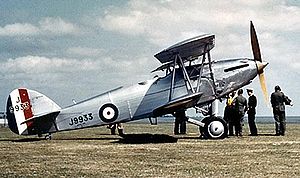The OP asked why the EE Lightning was shiny: maybe part of the answer was the Lightning never actually went to war (iirc). Shiny and colourful schemes were not confined to post-WW2 RAF aircraft, they were used in the 30s too. This 1937-built, 2009-restored Hawker Demon in 64 Squadron livery is from the Shuttleworth Collection, known sticklers for authentic colour schemes. Silver dope on the fabric and you can see your face in the cowlings.
Ah yes - preware Hawkers were such lovely planes ...
You're right, the Lightning was never used in anger.
That said, in light of the times, at least for land-based aircraft, these "bare" metal schemes were worn on other interceptors (MiGs, Mirages, F-100, F-104) and many fighter bombers (F-100, F-105, Vautour, etc) of the time (very late 50s to mid 60s), where tactics were employed around the weapons then in vogue - high altitude point defence interception with missiles, nuclear bomb-toss for the fighter bombers - and visibility - or the need to mask it - was largely irrelevant. Highest possible speeds played a huge role in those tactics, as opposed to maneuvering and/or using terrain - where the visual element is crucial.
While it's difficult to say what would have happened if the Berlin Crisis or any similar hotspot near the UK would have gone hot, I'd guess at least for the short term, and the Lightning paint scheme would not have been an issue. Vietnamese and Arab MiGs, Israeli and Pakistani Mirages and Ouragans, Vautours, etc all were engaged in hot wars/conflicts during the 60s - largely in unpainted schemes, and even though the tactics were largely more cut-thrust guns/low level, etc.
Notable exceptions I can think of are the Hunter (in Aden, etc), which always served in painted schemes. I can only surmise that from early on, it had a more low-altitude air-to-ground combat focus, hence it serving throughout its life in darker painted schemes. Just my guess, though ...
DL







